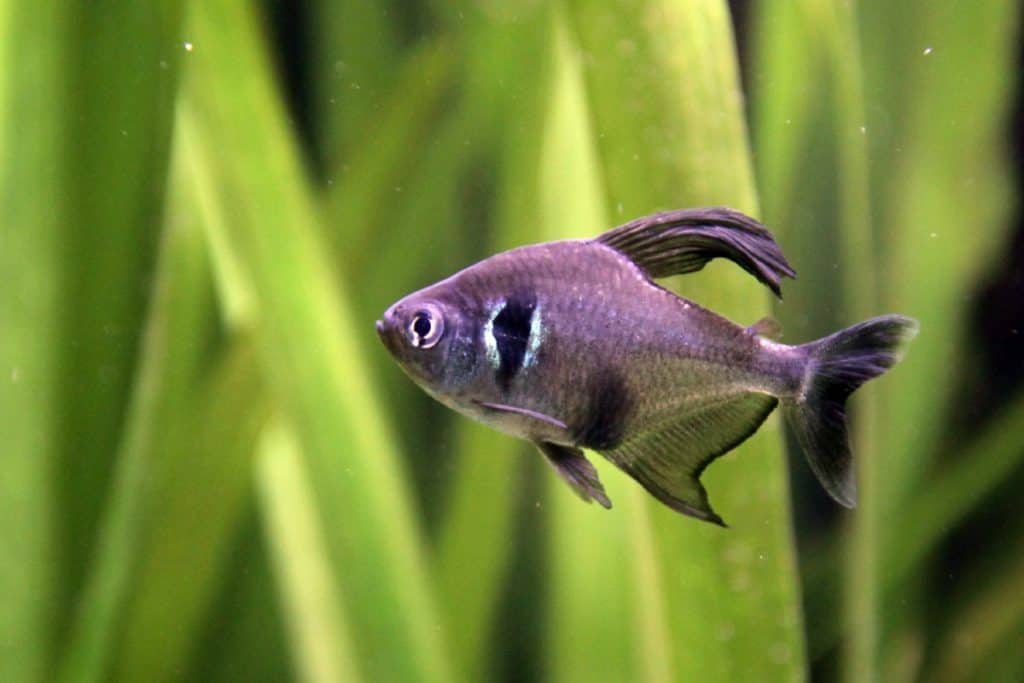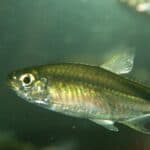So you have decided that the Black Phantom Tetra (Hyphessobrycon megalopterus) is the fish for you. What’s next?
Well, not all fish are alike! Every fish species requires different maintenance procedures and equipment to keep them healthy and colorful. So even if you have experienced caring for a fish before and know the basics, there may be some aspects of caring for the Black Phantom Tetra that are different. This complete guide will help you get off to a good start on your journey as a Black Phantom Tetra owner.
The Black Phantom Tetras (Hyphessobrycon megalopterus) are peaceful fish present in many hobby aquariums. Their most standout physical feature is the vertical black mark resembling an eye. Additionally, these fish are abundant in South America, being native species to the upper part of the Guaporé and Paraguay river basins.
From selecting the tank size and caring for them properly to knowing how to breed them, our guide will walk you through everything.
Species Summary

Spread over an area of South America, comprising Brazil and Bolivia, Black Phantom Tetra is a species of tropical freshwater tetra belonging to the Characidae family. The species occurs in different lakes and slow-flowing tributaries.
The body of the Black Phantom Tetra deserves a shout-out. It is translucent silvery gray, making it quite eye-catching to novice and experienced fish keepers.
Look aside; this hardy fish is relatively easy to care for and easy to spawn as well.
Black Phantom Tetra Care Guide
These fish can cohabitate with other peaceful community fish. This means you’ll never find them starting trouble with other fishes in the aquarium. But like other Tetras, the Black Phantom should be kept in groups of at least 6 individuals of the species.
Black Phantom Tetra are fairly low-maintenance fish to care for, so let’s quickly jump into the care section and look into how you can successfully keep them.
Tank Size
Black Phantom Tetras are very active fish. They like to venture throughout the entire aquarium, so you should provide them ample free swimming space. But, like most shoal fish, the more space and the greater the number of individuals in the shoal, the better for their welfare.
Tank Mates
When it comes to behavior, you don’t have to worry about your Tetra not getting along well with its tankmates. Being peaceful freshwater fish, they can thrive in a tank with countless other fish species. This provides you with lots of options when setting up your home aquarium.
But here’s the scary part: aggressive species could harm your Black Phantom Tetra or compete directly for food. So to be on the safe side, keep your Tetra in a tank with species of the same temperament.
Below is a list of compatible Black Phantom Tetra tankmates:
- Celestial Pearl Danio
- Most types of Rasboras
- Honey Gourami
- Keyhole Cichlid
- Dwarf Gourami
- Zebra Danio
- Cherry Barb
- Cockatoo Cichlid
Same Species Tanks
They are often used as a single species in assemblages of Biotope-type aquariums, where the original location of the species is imitated.
Water Parameters
Black Phantom Tetras are sensitive to pollutants in water. Proper water parameters are essential to keeping these fish healthy and thriving. The following are some key water parameters to keep in mind if you own a Black Phantom Tetra: temperature, pH, and hardness.
The perfect temperature for its maintenance is 68 to 82 F. Meanwhile, the ideal pH range is between 5.0 and 7.0, and hardness is between 18 and 215 ppm.
What to Put in Their Tank
Keeping your Black Phantom Tetra healthy in an aquarium requires installing a good filter system and an aquarium heater. These two pieces of equipment will help to keep the water temperature consistent, provide oxygen for the fish, and remove waste products from the tank.
In addition to these essentials, you should also add a variety of decorations to their tank, such as fine sand, driftwood, and a bed of dry leaves. This way, you can make their living environment feel much more comfortable and appealing.
Common Diseases
Black Phantom Tetras are incredibly disease-resistant fish. Despite their resistance, they still require regular water changes and a good diet to remain healthy.
Food and Diet
This species and other Tetras of the genus Hyphessobrycon are omnivorous, feeding on small invertebrates, filamentous algae, crustaceans, and fruits that fall into the water.
Its primary diet consists mainly of small invertebrates and algae in its natural environment. However, this fish readily accepts commercial feeds in aquariums without problems. Dry, live, and fresh foods such as daphnia, brine shrimp, bloodworms, and mosquito larvae can all be used to feed this fish.
Keep in mind that Black Phantom Tetras have big appetites. Hence, providing them with a varied and balanced diet is key to achieving large and healthy populations.
Lifespan
Black Phantom Tetras can live up to 3-5 years in an aquarium with all the correct parameters. They require a well-rounded diet, a good filter system, and an aquarium with plenty of swimming space.
Interestingly, their lifespan in nature is likely far shorter due to the prevalence of diseases, animal attacks, and environmental causes.
Appearance
Black Phantom Tetras exhibit a flat, tetragonal body, a broad anal fin, and a tiny fatty fin. Its body is also smoked in color.
Perhaps its most striking feature is the distinct black mark elongated vertically in the shape of an eye, located just behind the gills. This spot also contains an iridescent blue outline. This brand is what gives the fish its name.
Size
The Black Phantom Tetra fish can quickly grow to 1.4 inches in length when well cared for and fed.
Behavior and Temperament
This fish is known for its peaceful behavior and free hierarchy, which makes it ideal for beginner fish keepers. Black Phantom Tetras are also known for being sociable, and thus, it is essential to keep them in a group to show their natural behavior. A school of at least 10 Tetras will help stimulate their natural behavior and more enhanced colors.
Being enthusiastic fish, they show very high activity levels. They mainly occupy the middle part of the water column but also like to feed on the surface.
But that’s not all. Their peaceful behavior can change a little if they don’t feel comfortable hiding in the vegetation, rocks, logs, and even substrate. These Tetras will usually only attack if they feel threatened.
Breeding
Captive breeding of the Black Phantom Tetra is extremely simple and is carried out commercially and even accidentally in home aquariums worldwide.
Here’s how it works: the female Black Phantom Tetra freely dumps the eggs in the middle, with the male leading the female in releasing the eggs. The eggs will then be fertilized by the male; most of the eggs will go to the bottom of the aquarium or stay in the middle of a cluster of plants. They will hatch in 2 days, and larvae will swim freely for up to 48 hours.
The fingerlings are tiny, so they must be fed with paramecium or another type of infusoria until they are big enough to accept other foods.
Gender Differences: Male vs Female
Sexual dimorphism is apparent in the Black Phantom Tetra. The male is slightly smaller and has a more straight body. On the other hand, the female has a more robust body with a plumper shape.
Furthermore, male Tetras have larger black pelvic, dorsal, and anal fins while female ones have redder pelvic, anal, and adipose fins.
Generally, the fin’s color and shape is the most used character for sex.
Black Phantom Tetra Fun facts
● This species is prevalent in the aquarium hobby and can be commercially reproduced in several countries, including the albino form. Its collection in a natural environment still takes place today.
● It is native to the Madeira River, an important tributary of the western Amazon basin in Bolivia and west Brazil, including its main tributaries, the Beni and Mamoré rivers, and the upper Paraguay river in Brazil.
● Most records belong to the Guaporé river basin (Río Iténez, Bolivia), the main tributary of the Mamoré river, which drains into a vast tropical area known as the Pantanal, and the upper Paraguay river, which also has its headwaters in the Pantanal, but flows in the opposite direction. Guaporé and Paraguay are interconnected due to rising water levels during the annual rainy season. In Brazil, it occurs in the states of Rondônia and Matogrosso.
● To help trigger reproduction, add lots of vegetation, preferably thin-leaved plants, and use slightly softer water. Also, regarding the temperature, leave it a little higher than in the main aquarium and try to leave the reproduction aquarium with dim light.
● During mating, the male will swim in a circle or zigzag around the female until she has laid eggs.
● Due to their color, they stand out much more if the substrate is dark and the aquarium is well planted.
Final Thoughts
The Black Phantom Tetra can make an excellent addition to your home aquarium. The combination of their peaceful behavior and beautiful coloration makes for an enjoyable display in your living room. So get your Tetra now and watch them swim all the time!
References.
Britski, H.A., K.Z. de S> de Silimon and B.S. Lopes, 2007. Peixes do Pantanal: manual de identificaçäo, 2 ed. re. ampl. Brasília, DF: Embrapa Informaçäo Tecnológica, 227 p.
Lopez, H.L., R.C. Menni and A.M. Miguelarena, 1987. Lista de los peces de agua dulce de la Argentina. Biologia Acuatica No. 12, 50 p. (Instituto de Limnologia “Dr. Raul A. Ringuelet”).
Robins, C.R., R.M. Bailey, C.E. Bond, J.R. Brooker, E.A. Lachner, R.N. Lea and W.B. Scott, 1991. World fishes important to North Americans. Exclusive of species from the continental waters of the United States and Canada. Am. Fish. Soc. Spec. Publ. (21):243 p. Lima, F.C.T., L.R. Malabarba, P.A. Buckup, J.F. Pezzi da Silva, R.P. Vari, A. Harold, R. Benine, O.T. Oyakawa, C.S. Pavanelli, N.A. Menezes, C.A.S. Lucena, M.C.S.L. Malabarba, Z.M.S. Lucena, R.E. Reis, F. Langeani, C. Moreira et al. …, 2003. Genera Incertae Sedis in Characidae. p. 106-168. In R.E. Reis, S.O. Kullander and C.J. Ferraris, Jr. (eds.) Checklist of the Freshwater Fishes of South and Central America. Porto Alegre: EDIPUCRS, Brasil.








